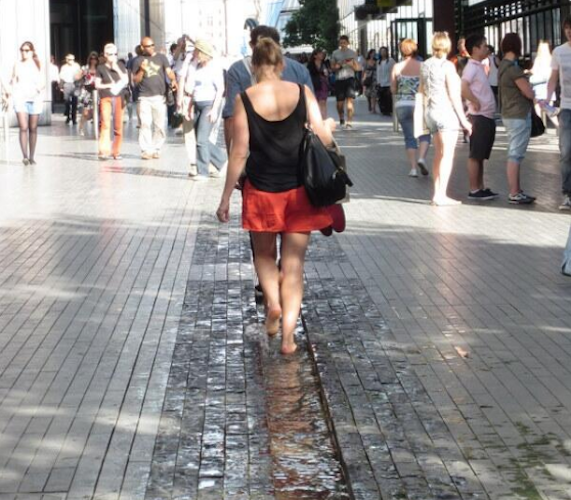It may be the circles I move in, but there’s been quite a lot of noise about the seemingly random infilling of the Rill which used to run the length of More Street near London Bridge. Designed by The Fountain Workshop, this 260 metre ground level, low key but elegant water feature formed a trinity with the Tooley Street Water Benches and the Riverside fountains within the More London development. Team London Bridge has said it was “regularly cited as one of the most distinctive and beautiful modern features in the area for visitors, families, and businesses.”
The Rill and the sightline it followed to Tower Bridge were More Street’s only redeeming features. Otherwise, it’s essentially a wind tunnel bisecting an unlovely stretch of clunky glass corporate blocks dwarfing their funkier neighbour City Hall. We are still waiting to see if the infill with limestone setts can be reversed, not least as it appears to have been done without prior planning permission.
The reduction of the Rill to “a rusticated scar down the middle of the pavement” seems perverse when London’s public spaces are coming alive with new water features, both decorative and functional.
During this summer’s heatwave, Time Out ran a feature on public fountains, with More London’s cited as “best for splashing with a view”. Decorative fountains and water, natural or canalised, are not new to London where identity, sometimes shared and sometimes divided, is strongly tied to position vis à vis the River Thames. London’s fountains are as diverse as its inhabitants. Commemorative, artistic, contemplative, playful, historic, contemporary, there’s one to suit every taste, be it Naum Gabo’s stainless steel Torsion at St Thomas’ Hospital, the multicoloured upstarts of Granary Square, or The Huntress in Hyde Park – the bronze creation of Feodora Gleichen, the first female member of the Royal Society of British Sculptors (albeit a posthumous award).
2018 is also the year the drinking fountain returned to London, the city where the contaminated Broadwick Street pump provided Dr John Snow with the evidence that cholera is water, not airborne. The Mayor’s Drinking Water Fund has so far seen a first wave of 20 new ones installed across the capital. They’ve been quite a hit, and ideas for more include Open City/Graeme Nicholls’ 99 fountains celebrating women from all walks of life who have shaped London through the ages.
Besides cause du jour single-use plastic reduction, there are plentiful other public health reasons to make it easier (and free) to drink fresh water, as cities like Melbourne and Toronto have been demonstrating for some time. It’s clearly better for us than consuming expensive sugary or caffeine fuelled drinks on the go, and more effective at keeping us hydrated in hot weather. What’s more, there’s increasing evidence that, as well as arts and culture, access to “blue space” is good for our health and even better than green space at reducing health inequalities. A beautifully designed drinking water fountain in a well maintained accessible civic space scores a lot of public health points without a hint of worthiness.
Ironically, the reputed reason for the Rill’s infilling is a health and safety one. According to media reports, people on mobile phones were falling in it. To my mind, it is features like the Rill which invite us to put away those phones, pause, and take notice: one of the five ways to wellbeing we should be promoting for World Mental Health Day on the 10th October.
I just hope that all this water provides further impetus for the return of the free public loo.
This blog was originally commissioned by London commentator Dave Hill and published on the OnLondon website. The accompanying image is from the Twitter feed of Felicity Hayes-McCoy.



